So… I switched to ConvertKit.
When I tweeted about it, the response was insane. After all, I’d created the leading course on Drip and those who know me know that for years I’d touted Drip as the most sophisticated, extensible, and most reliable email marketing product on the market.
1) Drip really, really screwed up with this one
2) Today I signed up for @ConvertKit – which is something I've been wanting an excuse to do for a *very* long time
3) Keep an eye on https://t.co/M9Uf3dwBmX – going to be porting my advanced automation course over ASAP https://t.co/ZRu3qjJTFb— Brennan Dunn (@brennandunn) January 3, 2019
But a series of changes, both at ConvertKit and Drip, led me to make this decision. And in this writeup, I’m going to attempt to talk about why I’m moving my entire business to ConvertKit.
My history with ConvertKit and Drip
OK, so ConvertKit was founded by Nathan Barry and Drip was founded by Rob Walling.
Both of these gentlemen I consider really good friends of mine.
When I decided to move off Infusionsoft, I ended up signing up for Drip.
Why?
Positioning.
At the time, Drip was targeting SaaS businesses and ConvertKit was going after bloggers. I ran a SaaS (Planscope) that had a blog, but I didn’t (and, truthfully, still don’t) consider myself to be a blogger.
So I went with Drip.
More on positioning in a bit…
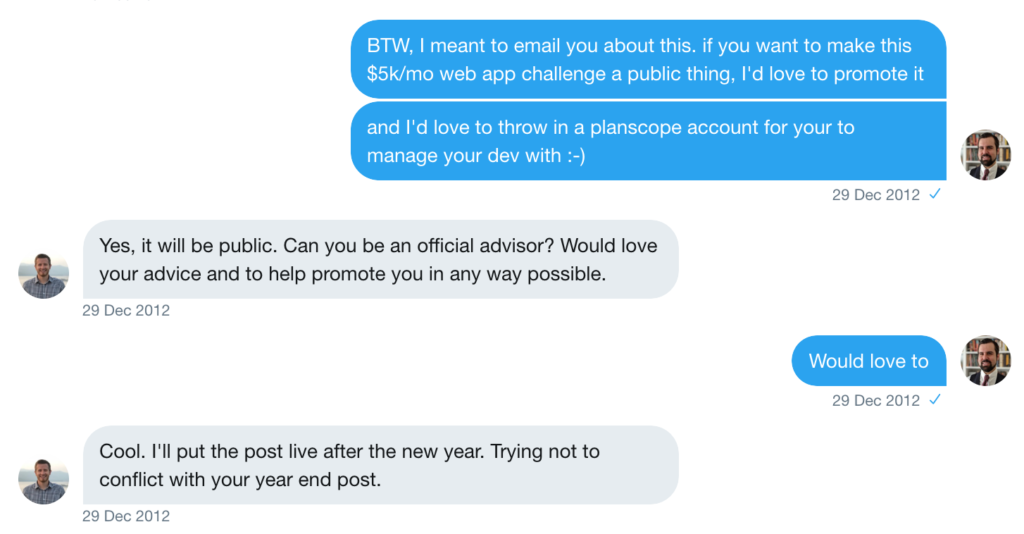
To be totally honest with you, there was a bit of a weird dynamic that came from being friends with both Nathan and Rob, and deciding to stake the business on Drip. This weirdness was amplified when I started evangelizing Drip and (accidentally) poaching big accounts away from ConvertKit and over to Drip.
But Drip was more advanced – it supported a number of things that ConvertKit didn’t, which included events/actions, visual automations, really flexible and creative uses of Liquid (across all facets of the product), and more. Some of these ConvertKit still doesn’t support.
In talking with Nathan over the years about why I kept using Drip, especially after Rob and much of the founding team left (Drip was acquired by LeadPages), I always came back to something like: “I have a weird laundry list of pretty advanced requirements that the average company probably won’t ever need. I have a bad habit of tinkering too much. Keep doing what you’re doing – it’s more than enough for most.”
ECRM
After Drip was acquired by LeadPages, I continued banging the Drip drum.
I’d been invited to speak at their Converted and Automated conferences, and even gave a private talk to their internal team at their headquarters in Minneapolis.

Rob and Derrick (co-founders of Drip) were still with the company, and – despite some deliverability issues that mostly had to do with job queueing – the product was continuing to mature and get better, adding features like content snippets.
But in the autumn of 2017, Drip decided to go all-in on ecommerce.
Their positioning shifted from lightweight marketing automation software (yay!) to ECRM, which is “the first CRM resource built by and for ecommerce specifically.” (read the ECRM manifesto here)
I completely understand why they made this move.
When LeadPages acquired Drip, a free plan was announced. And my awareness of LeadPages was, and still largely is, as software that makes it easy for generally non-savvy people to quickly spin up landing pages that deliver variations of “The Top 8 Ways To Live Your Best Life” ebooks.
This brought over a type of customer that I’d imagine is hard to support and hard to make much money from.
As this shift toward ecommerce started to happen, I noticed that Drip started to seriously invest in and scale up a sales team. It was obvious that they were going after big fish who with giant lifetime values. They were going after another type of customer than they had in the past.
This bothered the Internet, but it didn’t really bother me.
After all, Drip the product hadn’t changed.
It had a new design (which… I have thoughts about) and a new marketing site, but it still let me setup advanced automation sequences and do all the Drip-y things I’d come to know and love.
“What’s going on…?”
And then the scaling and support issues began…
Over the years, I’d sent a number of customers to Drip. Between the conference talks, podcast appearances, guest posts, courses, and more, a number of people had switched to Drip because of my recommendation.
I started to get emails and DMs from people I had sent to Drip asking, “What the heck is going on over there?”
Support requests were being ignored or brushed under the rug, and I saw plenty evidence of this first-hand in the Drip Facebook group.
In Drip’s defense, they admitted that they were having issues with scaling support. They’d hired a new support manager, and they were still getting up to speed, scaling the team, etc.
But when your business is being held back because the software you’re using and paying for isn’t actually supporting you, a software vendor’s internal support issues don’t matter. You need this fixed. And you need it fixed now. Cries for help in the official Facebook group that are met with “Please email support@…” and then, days later, updated by the OP with “I contacted support but no one responded” aren’t acceptable. Full stop.
Because I had made the recommendation, I was (rightfully) blamed by a lot of the people I had referred.
I stand by the things I recommend, and the truth is the product and company I’d been recommending changed. And, reputationally, this hurt me.
There was also little visibility into the direction that the product was going.
Would upcoming features be built for their new, larger ecommerce customers?
And would this mean people like me (and those I referred) – the sort who are actively building an online following, email them frequently, and selling courses and other digital products on their websites – would we be left out in the cold?
(I mean, I guess selling digital products is technically ecommerce… but no one I know, who self identifies as a creator, says they run an “ecommerce company.”)
Proactively, I started to talk to Nathan about what it would take for me to switch over.
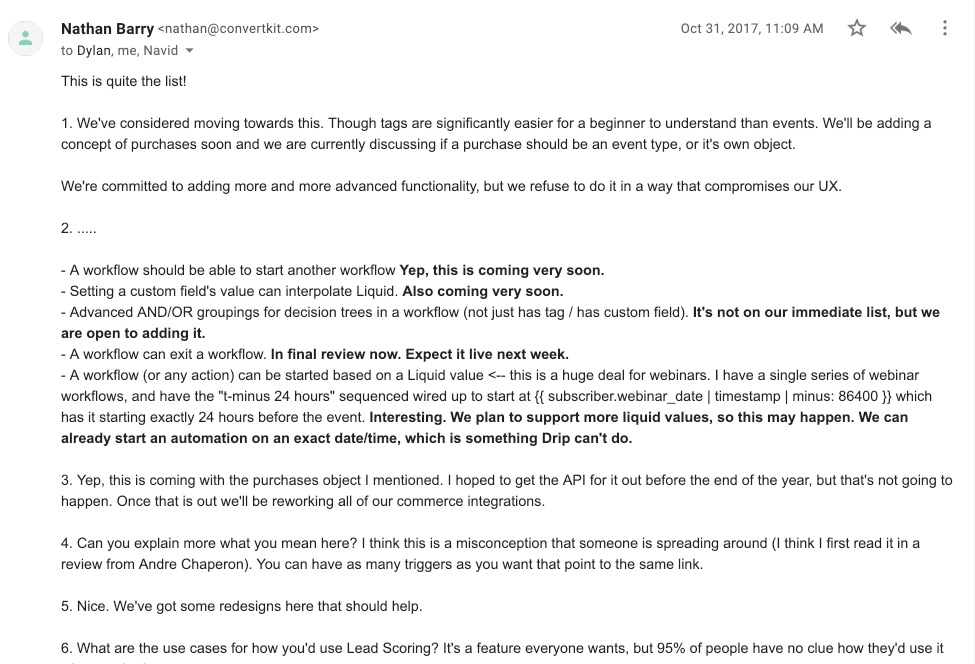
And oh so refreshingly he wrote back like Nathan, the guy who had called me back in 2012 to talk about this “email marketing app he wanted to start.”
Even with a growing team of 30+, he’s listening to his customers (or, in my case, non-customers!) and shedding light on the product and its direction in a way I hadn’t experienced since back when Rob Walling was at the helm of Drip.
The great price hike of 2019
A few months ago, every Drip customer (who was paying monthly) was sent the following email:
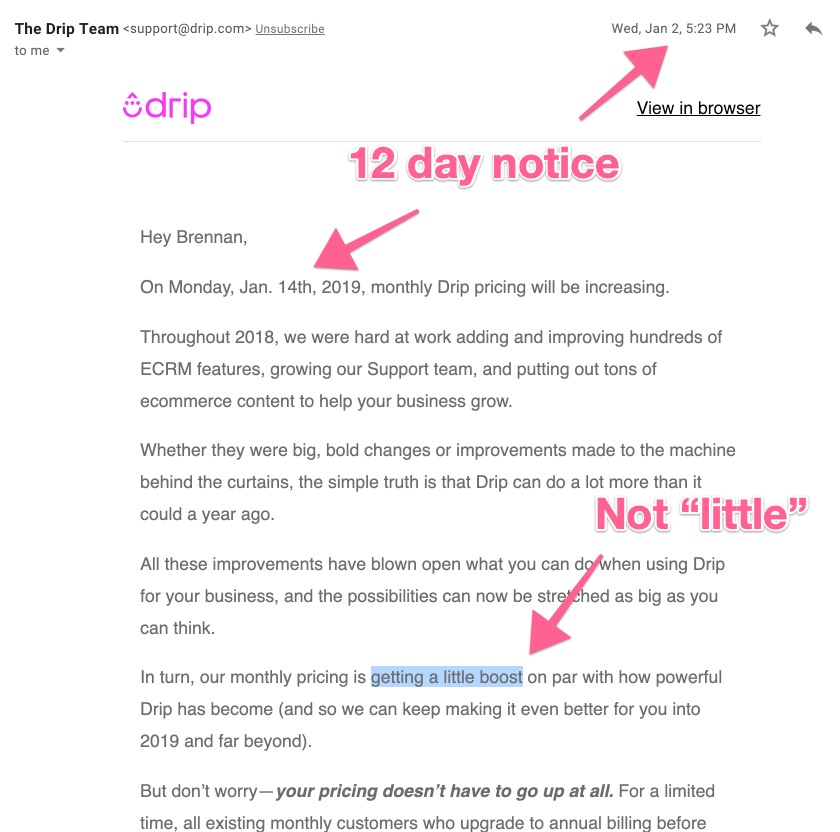
Now, I’m a dyed-in-the-wool-Patrick-McKenzie-following-“charge more!”‘er
But for me and quite a few others, this was the last straw.
When I teach freelancers how to raise prices, I make it clear that a hike in pricing should correlate with a hike in value. If you’re going to make yourself twice as expensive starting tomorrow, show your client exactly why they should gladly be paying you more – how have you made an impact on their business, and what do you plan on doing to make an even greater impact in the future?
For many of us, our next bill would be twice the price and while they’d been growing the support team, building features, and so on, there were a lot of us scratching our heads…
“But there are still a ton of support problems?”
“The only new feature I really noticed was the visual email editor, which I don’t even use…”
“My deliverability has tanked over the last few months, and no one on the support team has acknowledged this or helped…”
The above are a few examples of some of the feedback I heard from those I’d referred to Drip who were confused and angry by the new pricing. In a world where what-you-paid-when-you-signed-up-is-what-you’ll-pay-forever, being told that your price is going up two-fold in less than two weeks shatters just about any trust you might have with a company, especially one where you’ve staked so much of your business on.
And when there’s little transparency, it makes continuing to justify why you’re sticking around even harder.
If it wasn’t for the pain and agony of moving your list, recreating your automations, setting up new forms and getting them live on your site, etc. more would have probably switched sooner, but once you’re bought into an email marketing app it’s pretty hard to leave it.
And then I got booted…
All this is what led to me tweeting what I opened this post with.
Most of my tweets get a handful of likes, but this one got… quite a bit more than average. And it got a ton of replies.
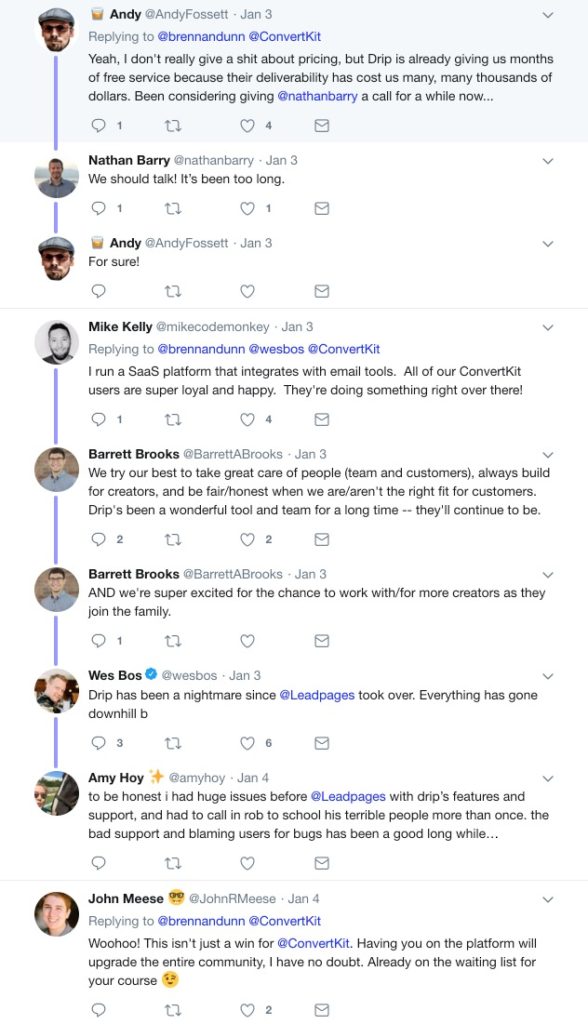
It also got me kicked out of the official Drip Facebook group, which I’d been a member of really since the beginning and had individually helped hundreds of people (often when Drip support was radio silent.)
I woke up the morning after tweeting about switching to ConvertKit and saw that I couldn’t access the Drip FB group.
Was Facebook glitching? Did they delete the group? I decided to ask the private community for Mastering Drip:
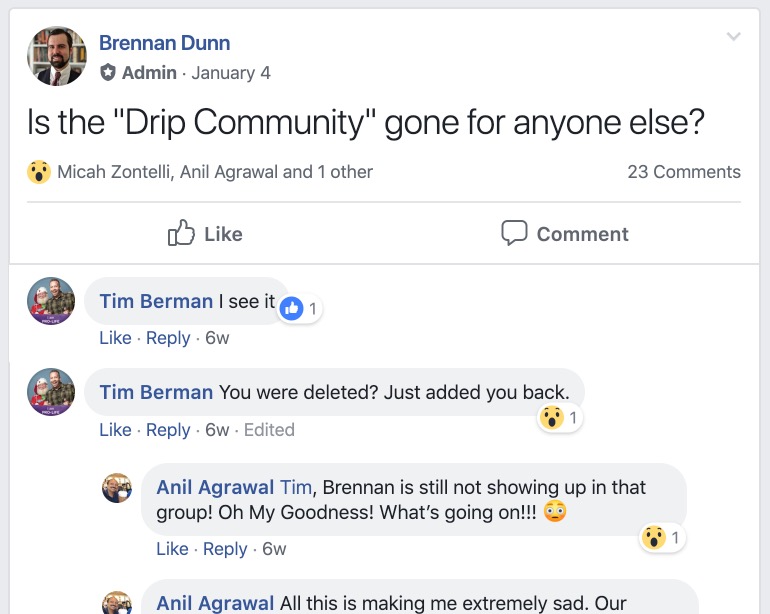
Nope! They all had access. So Tim from the group decided to ask in the Drip Facebook group:

I was told I’d been accidentally banned because my tweet was mistook as a cancelation, which I guess is grounds for removal from the Facebook group.
What really hurt was that, again, I’d done so much in that group and had never spoke negatively about Drip. In fact, when the “OMG what is all this ECRM stuff?!” came up, I’d be the first to rush in and say that it was just a positioning change and probably wouldn’t affect any of us who don’t run ecommerce companies (at least not anytime soon.)
John Tedesco, the CEO of Drip, reached out and wanted to talk on the phone. I’d honestly told him that I thought the way the pricing change was handled and the support issues were causing a lot of people I’d referred to Drip to get upset, which reflected poorly on me.
John and I talked about Drip’s positioning, and how the product was moving heavily toward ecommerce and customers who don’t fit that profile were no longer their target market.
Again, perfectly OK. They have data that I don’t showing that this is a good move, and truthfully part of this pricing change was likely to fix their support issues – by charging more, they were effectively culling the herd from lower revenue / higher support customers.
“No hard feelings, but I’ll continue to refer Shopify and large ecommerce people to Drip, and others to something like ConvertKit or ActiveCampaign.”
Where before my recommendation was “all Drip, all the time,” I’m now going to be more nuanced and try to recommend what I think the best tool is for the job.
- Ecommerce? Heavily use Shopify? Drip.
- Have a lot of CRM-y needs? ActiveCampaign.
- Blogger/creator type who sells digital products? ConvertKit.
ConvertKit’s positioning squarely aligns with me and my needs, and I absolutely love the team behind the company.
They’re 100% transparent, open, and accommodating. Email marketing platforms are a big deal, and I like knowing that the team at ConvertKit knows who their customers are and maintains an open dialogue with them.
Why I’m excited to use ConvertKit
There have been a few roadblocks that have kept me from switching over but – guess what?! – Nathan & team are committed to supporting people like me.
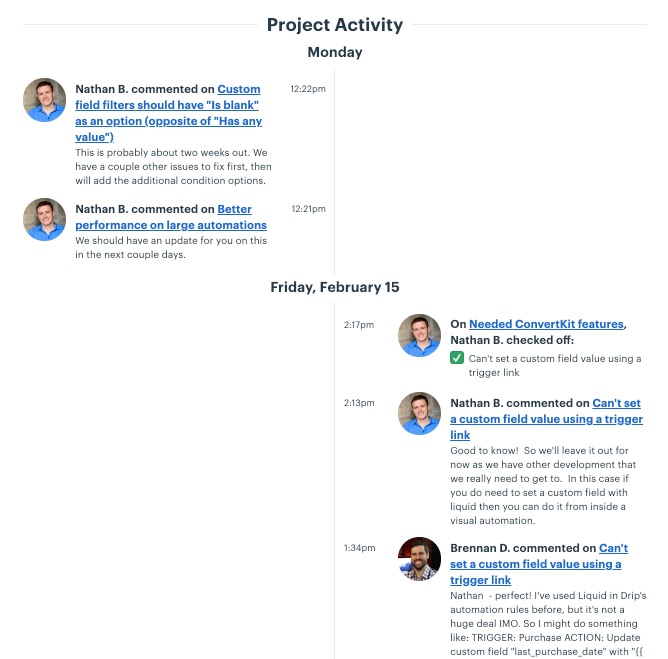
Not only are all the functionality gaps that have kept me from switching in the past being patched, but Nathan’s committed to keeping his ears to the ground and listening to what creators like me need.
And that’s why I’m now fully backing ConvertKit: they have a product that’s constantly getting improved, they’re serious (and open) about deliverability, and I absolutely love the team behind the product.
I’ve ported my Mastering Drip course over to Mastering ConvertKit, and you can have immediate access now.
(The tl;dr on Mastering ConvertKit: it’s a complete, in-depth course on how to strategically using ConvertKit along with RightMessage to build an audience, learn what they need, and systematically converting subscribers into customers using advanced automation tactics. This isn’t a basic “how to” on ConvertKit – it’s a masterclass on how to sell more effectively using your website and ConvertKit.)